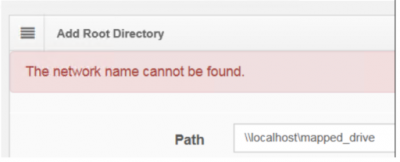User Tools
Sidebar
Add this page to your book
Remove this page from your book
Root directories, mounting points, and network data
It is common that WSI data is not stored on the local drive, but on a shared (high-capacity) storage device. There are several reasons why this may be the case:
- This machine may collect files from different locations and/or scanners.
- The system requirements for your file server may also vary significantly from the requirements of PMA.core.
- Last but not least, you may simply want to access data for a temporary project that's stored somewhere else at your company or institute, without having to go through the trouble of copying several terabytes of data.
PMA.core therefore lets your map root-directories on a (shared) network drive. A UNC-path to a networked directory looks like \\servername\sharename\dir\subdir\. There are three conditions for this:
- The UNC share must exist at the time of creation
- The IIS account running PMA.core must have sufficient access rights to the specified path
- The share may not be accessed through a mapped drive; but only through a fully qualified UNC path
If no immediate access is possible for the share, you may specify impersonation information (which should be provided to you by the system administrator who's responsible for the machine that you're trying to reach). Impersonation information is verified, and the root-directory may only be created if impersonation is successful.
You must specify a domain. If no domain-name was given to you (e.g. on a Samba-share), you may enter “.” as a default domain.
When a UNC share does not exist, the following error message is displayed:

Note that you can only map network locations through their UNC path. PMA.core does not allow mapped (network) drives to be referenced directly. If \\servername\sharename\ is mapped as drive X:, you can not create a root directory with the path reference x:\dir\subdir\. The reason for this is twofold:
- A file needs to be traceable to an unambiguous location. There's no way to find out whether
\\servername\sharename\dir\subdir\foo.svsandx:\dir\subdir\foo.svsare the same files (at least not in a simple straightforward manner) - Since IIS runs as a background service in the OS, it cannot be guaranteed that the
x:drive-letter will always be available (especially when no actual user is logged into the system).
A note about (mapped) network drives
In many organizations, it is commmon to map network paths to a drive letter. It's easier to remember that all the images are stored on the shared I: drive, rather than in the k\\server_emea_48F\content\shared\incoming_slide_data\. PMA.core needs the latter path however to be able to mount content, rather than the I: drive letter. You cannot use the I: drive letter as a reference when attaching a new mounting point to a root directory.
The reason for this is that your I: drive letter is a transient designation that only exists when you're logged in. In a server content (PMA.core is a server application running on Microsoft IIS server), the software runs unattended (i.e. without a human being logged on to the machine). The drive letter therefore is not available (in unattended mode), but the network path is.
Think of root directories then as PMA.core's own alternative to mapped network drive letters on your local computer.
